You may have colleagues who’ve served medical missions, and perhaps you’ve been thinking about doing one yourself — but do you know how to make it happen? There are a lot of options and organizations out there, but it’s important to be thoughtful about who you travel with and what you want to accomplish. Here are some best practices for figuring out how to serve a medical mission that’s both effective and meaningful.
Choosing a location for your medical mission
When deciding on the right place to serve a medical mission, consider:
- Your interests
- Medical training
- Family history and interests in heritage
- Places you’ve always wanted to visit
- The time you have available
- The season when you’d like to travel
You may already have a specific country or mission in mind, but it’s important to think about your goals for the trip to figure out the right location.
“I always ask providers for their passion and look at their overall goal. Sometimes they’re looking for a particular location, and sometimes they’re looking for a particular style of trip,” says Shauna King, founder and president of International Medical Relief.
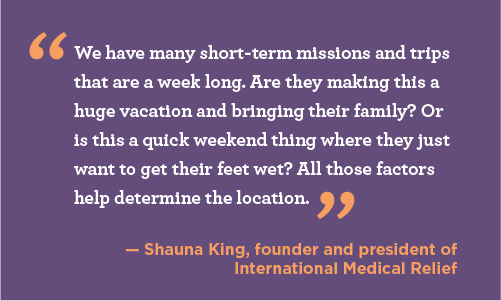
Physicians also need to think about trip duration. “We have many short-term missions and trips that are a week long. Are they making this a huge vacation and bringing their family? Or is this like a quick weekend thing where they just want to kind of get their feet wet?” asks King. “All those factors help to determine the location.”
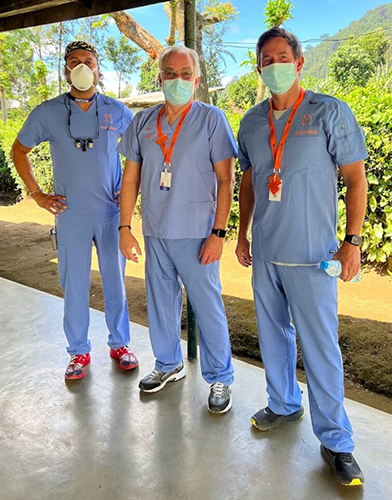
Amy Jordheim, medical advisory board chair at International Medical Relief, also asks providers about the patient load they can handle and the types of patients they like to treat.
“I ask them to tell me what they love, why they want to go on this trip, what is important to them. Then we talk about it, and I give them different options and scenarios,” she says. “It’s overwhelming, I think, for people to try to decide from the big picture, but once you get them to narrow it down, it becomes very clear to them very quickly.”
Dr. Farhaad Riyaz, a dermatologist who works with CompHealth, recently returned from a medical mission to Tanzania sponsored by the Making a Difference Foundation. He says he was drawn to Tanzania by its people’s urgent medical needs and a safe environment for medical intervention.
“I wanted to use my skills in a challenging environment and fulfill my passion for educating foreign healthcare workers,” Dr. Riyaz recalls in his blog post about the experience. “Each patient seen by International Medical Relief (IMR) that week carried a story of endurance, of a life spent in the shadows of a system that had forgotten them.”
Deciding on an organization to work with
Sarah Ehlers, cofounder of the nonprofit A Broader View Volunteers, recommends working with nonprofit organizations so you can verify the cost and expenses and see where the organization is using the money.
“Check GuideStar, which is a nonprofit service organization referral. At A Broader View, we don’t hesitate to put volunteers in contact with alumni so they can talk about their experiences. They get a better understanding of what a medical mission is and what the entire experience would be like before they make a final decision,” Ehlers says.
“We encourage tons of research and provide documentation and general expectations, packing lists, immunizations, information about navigating airports, and sample itineraries,” she adds.
Other important factors to look for in medical missions organizations include:
- Licensing
- Insurance to protect volunteers and patients
- Sustainability (how many years the organization has been in business)
- Ground staff available for follow-up patient care
- Safety during the mission
“Look at organizations that work directly with the World Health Organization, which captures data and provides those statistics to the local health bureaus. You also want an organization that values clinical skills, where titles are left at the door, and everybody collaborates very closely in clinics to provide expertise for patients,” Jordheim says.
She continues: “Look at organizations that are broad enough in their provider base to provide the expertise that these patients need. Consider not just what the organization provides to the volunteer, but what the clinic setup provides for the volunteer and patient to function in a quiet, professional environment.”
Weighing the length and cost of medical missions
The length of your medical mission trip will vary depending on what the organization offers and the time you have available, but it can range anywhere from a few days to several months. This also depends on whether you only want to volunteer or also want to explore the area.
“If providers go on very short trips, no sightseeing is included. We’re very focused on the clinical aspect, but in the evenings, they can expect to maybe stop at a sightseeing venue, get an ox cart ride, or maybe join the village for dinner,” Jordheim says.
“All of the places we partner with give back in a very cultural way by providing a meal or having people come to their homes for tea after clinic. Often, the school kids get up a band to welcome you when you get off your bus,” she continues.
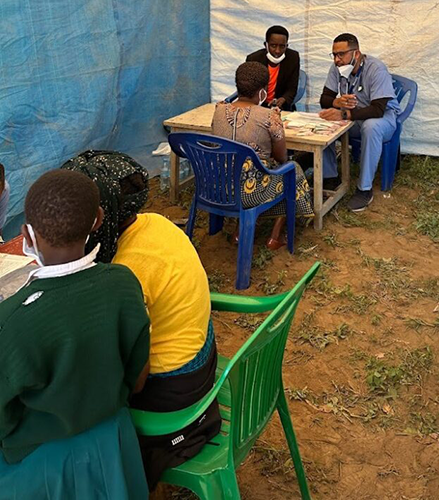
King notes that most medical providers are using their vacation time for medical missions and only have one or two weeks to volunteer. However, longer trips are available as well.
“When we’ve had doctors or nurses who were in between jobs or on a sabbatical or changing career focus, we’ve had medical providers in projects as long as a month or two,” she says. “We try to offer everybody an opportunity based on when they are available to participate.”
The cost varies by the length of the mission and the organization you travel with, but short trips start around $750-$900, and longer ones can be $5,000, not including airfare. Determine whether clinic fees, meals, and other supplies are included when planning your trip. Some organizations offer in-house scholarships or ways to save money. Donations from fundraisers providers receive when working with nonprofits are also tax-deductible.
Even short medical missions can be invaluable, Dr. Riyaz explains.
“The Tanzanian shortage of doctors is in the hundreds of thousands. Even though it was only four days that we were there, that day was probably life-changing to many people — that one day that they got to see an American doctor and get treated,” he says. “That need is ongoing and will continue to grow as their population continues to grow.”
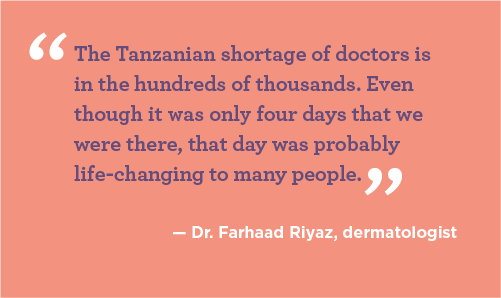
Preparing for a medical mission
Ehlers recommends starting to prepare for a medical mission three to six months before you leave.
“This allows you plenty of prep time. You must have immunizations for most of these trips, and some countries require visas,” she says. “Plenty of prep time is necessary to participate in one of these international trips.”
However, many organizations can work with your schedule if you suddenly realize you have time off to fill and already have a passport. Jordheim notes that many countries issue e-visas to speed up the process, and their organization’s connection to the Ministry of Health also streamlines communication.
“We give providers disclosures on the vaccinations required, and they get the information they need almost immediately upon joining the team,” she says. “They also get a personal call from their team leader so the leader can answer any questions.”
King recommends finding an organization with training tools already in place so you get enough information no matter how quickly you’re planning a trip.
“We have provider guidelines and provider practice, a lot of written material that’s been vetted and approved by the medical board. We’re very confident that our materials will get providers to a place of ease in our clinic, even if it looks different in scope from their normal practice on a day-to-day basis,” King says.
Dr. Riyaz notes that everyone who embarks on a medical mission is looking for a way to be helpful, and it’s important not to downplay your abilities.
“You might not even realize that you have a skill that you learned kind of briefly and took for granted — but you might be the best option that someone in Tanzania has,” he says. “It really is a place where you can kind of double-down on some of the things you learned and practice to the best of your ability.”
What to expect when you get to your mission location
Once you embark on your medical mission, you’ll usually have a meet-and-greet at the airport and an orientation with the medical staff you’ll be working with. Staff will help you get familiar with the community, get settled in your accommodations, and know what to expect. They’ll also explain how to exchange money, find stores to buy sim cards or cell phones, and buy any last-minute supplies.
“Groups organizing a medical mobile clinic or outreach clinic will have time to set up the clinic, usually separating into different areas like registration, triage, and exam. If the group brought medications, there might be a pharmacy and counseling area,” Ehlers says. “The tents and the set-up can be arranged, and team members and translators will be available so you can sort of have a game plan before all the patients come in.”
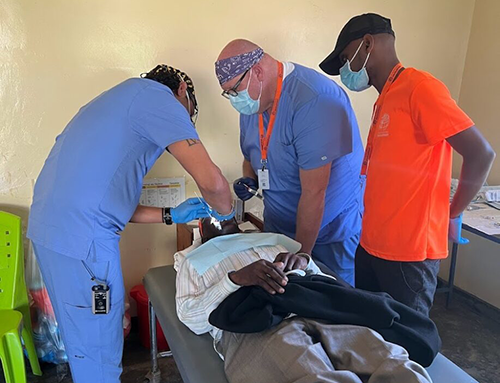
If your mission is a week or less, volunteer work will start as soon as possible, but you’ll have free time in the evenings. Make sure to ask questions early, so you have an idea of the schedule and the tasks ahead of you.
It’s also worth considering the continuity of care after your medical mission ends, as you will quickly meet new people you may never see again.
Dr. Riyaz recalls that as his time in Tanzania ended, he and the other physicians working there wondered what would happen when they left. Fortunately, they had met and trained Dr. Lister John Seremon, a young Tanzanian doctor who accompanied the IMR team.
“Seremon, now familiar with procedures like cyst and lipoma removal, represents a glimmer of hope,” Dr. Riyaz explained in his blog post. “We exchanged contact information, establishing a line of communication for future consultations on complex cases.”
Starting your journey to a medical mission
A medical mission is a great way to get back to the roots of medicine while expanding your clinical and personal experience — and it’s easier to do than you might think.
“Take the opportunity to go. Sometimes, when providers decide to go, they are retiring and have the time, but their medical license is expiring, so they only get to go on one trip. They always say, ‘I wish I would have done this earlier,’” King says. “Seize the day. Take the opportunity to just go for it.”
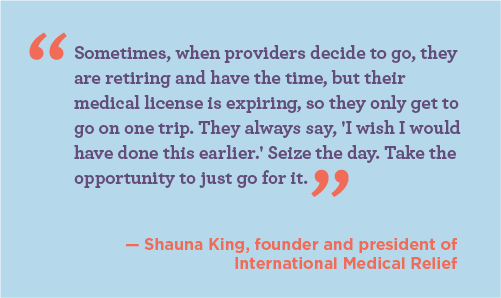
Dr. Riyaz says that medical missions help your soul and remind you to simplify your life.
“You definitely become a better person after taking trips like this. You meet wonderful people. Your network grows. I think all of us came back as different people,” he recalls. “Hopefully, you catch the bug, and you continue to help other people and think about the diversity of lifestyles that people live and the low resources some people on this planet (which we all share) have. There aren’t enough people thinking about how to help others, and it enriches your own life if you choose to do it.”
Are you interested in learning more about serving a medical mission? Connect with the Making a Difference Foundation about a grant to plan your medical mission by calling 866.608.1322 or emailing information@makingadifferencefdn.org.
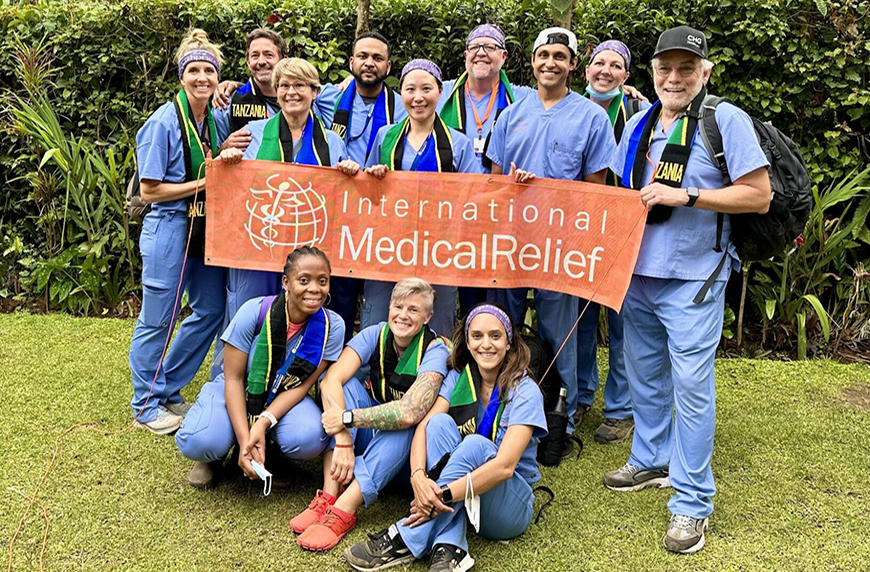 Blog
Blog